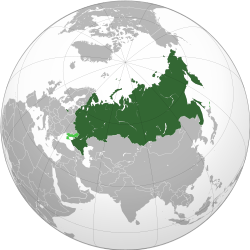| Russian Federation (originally the Soviet Union) | |
|---|---|
 | |
| Nuclear program start date | 1942[1] |
| First nuclear weapon test | August 29, 1949 |
| First thermonuclear weapon test | November 22, 1955 |
| Last nuclear test | October 24, 1990 |
| Largest yield test | 50 Mt (210 PJ) (Tsar Bomba) |
| Total tests | 715 detonations |
| Peak stockpile | 46,000 warheads (1975) 45,000 warheads (1990) |
| Current stockpile | 5,580[2] (2024) |
| Current strategic arsenal | 1,710[2] (2024) |
| Maximum missile range | 18,000 km[3] |
| NPT party | Yes (1968, one of five recognized powers) |
The Russian Federation is known to possess or have possessed three types of weapons of mass destruction: nuclear weapons, biological weapons, and chemical weapons. It is one of the five nuclear-weapon states recognized under the Treaty on the Non-Proliferation of Nuclear Weapons and one of the four countries wielding a nuclear triad.
Russia possesses a total of 5,580 nuclear warheads as of 2024,[2] the largest confirmed stockpile of nuclear warheads in the world. Russia's deployed missiles (those actually ready to be launched) number about 1,710, also the largest confirmed strategically deployed arsenal in the world as of 2024.[4][5] The remaining weapons are either in reserve stockpiles, or have been retired and are slated for dismantling. Russia's predecessor state, the Soviet Union, reached a peak stockpile of about 45,000 nuclear warheads in 1986.[6] The number of weapons Russia may possess is currently controlled by the bilateral New START treaty with the United States.
The Soviet Union ratified the Geneva Protocol—prohibiting the use of biological and chemical weapons in interstate conflicts—on April 5, 1928, with reservations that were later dropped on January 18, 2001.[7] Russia is also party to the 1972 Biological Weapons Convention and the 1993 Chemical Weapons Convention.[8][9] The Soviet biological weapons program violated the Biological Weapons Convention and was the world's largest, longest, and most sophisticated program of its kind.[10] At its peak, the program employed up to 65,000 people.[10]
Despite being a signatory to the Chemical Weapons Convention, Russia has continued to hold, and occasionally use[citation needed], chemical weapons. In 1997, Russia declared an arsenal of 39,967 tons of chemical weapons, which it worked in part to decrease.[11][12] Its stock of weapons was officially declared destroyed in 2017. The poisoning of Sergei and Yulia Skripal in 2018 and the poisoning of Alexei Navalny in 2020, both carried out by Russia, revealed that the country maintained an illicit chemical weapons program.[13][failed verification] Russian forces also used[citation needed], and admitted to using[citation needed], chemical weapons during the invasion of Ukraine.
- ^ Sublette, Carey (December 12, 1997). "The Soviet Nuclear Weapons Program". nuclearweaponarchive.org. nuclearweaponarchives. Retrieved April 20, 2017.
- ^ a b c "Russian nuclear weapons, 2024".
- ^ "Army 2019: Russian army discloses RS-28 Sarmat ICBM characteristics". Army Recognition. July 2, 2019.
- ^ "Status of World Nuclear Forces – Federation Of American Scientists". Fas.org.
- ^ "Nuclear Weapons: Who Has What at a Glance". armscontrol.org.
- ^ Kristensen, Hans M.; Norris, Robert S. (2006). "Global nuclear stockpiles, 1945-2006". Bulletin of the Atomic Scientists. 62 (4): 64–66. Bibcode:2006BuAtS..62d..64N. doi:10.2968/062004017. S2CID 145147992.
- ^ "Disarmament Treaties Database: 1925 Geneva Protocol". United Nations Office for Disarmament Affairs. Retrieved February 7, 2021.
- ^ "Disarmament Treaties Database: Biological Weapons Convention". United Nations Office for Disarmament Affairs. Retrieved February 16, 2021.
- ^ "Disarmament Treaties Database: Chemical Weapons Convention". United Nations Office for Disarmament Affairs. Retrieved February 7, 2021.
- ^ a b Leitenberg, M., Zilinskas, R., & Kuhn, J. (2012). "Conclusion". In The Soviet Biological Weapons Program (pp. 698–712). Cambridge, Massachusetts; London, England: Harvard University Press. Retrieved February 7, 2021, from JSTOR j.ctt2jbscf.30
- ^ Cite error: The named reference
NTIchemwas invoked but never defined (see the help page). - ^ "Opening Statement by the Director-General to the Conference of the States Parties at its Sixteenth Session". OPCW. November 28, 2011. Retrieved May 1, 2012.
- ^ "Syria, Russia, and the Global Chemical Weapons Crisis". Arms Control Association. Retrieved March 1, 2022.
